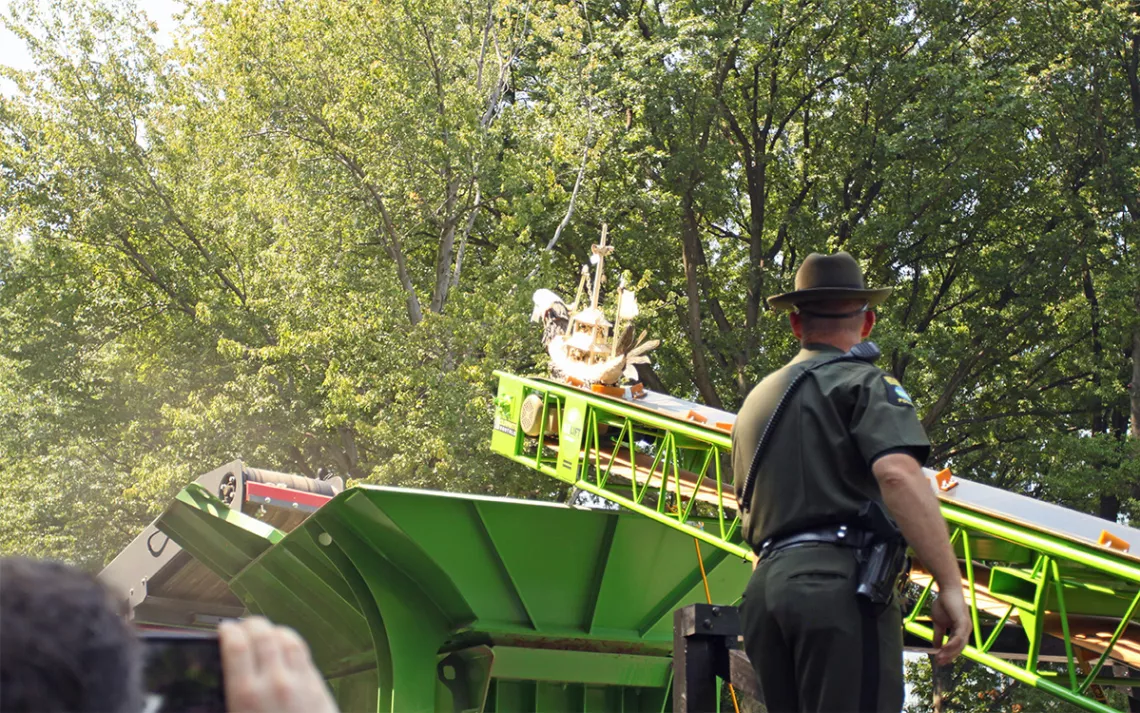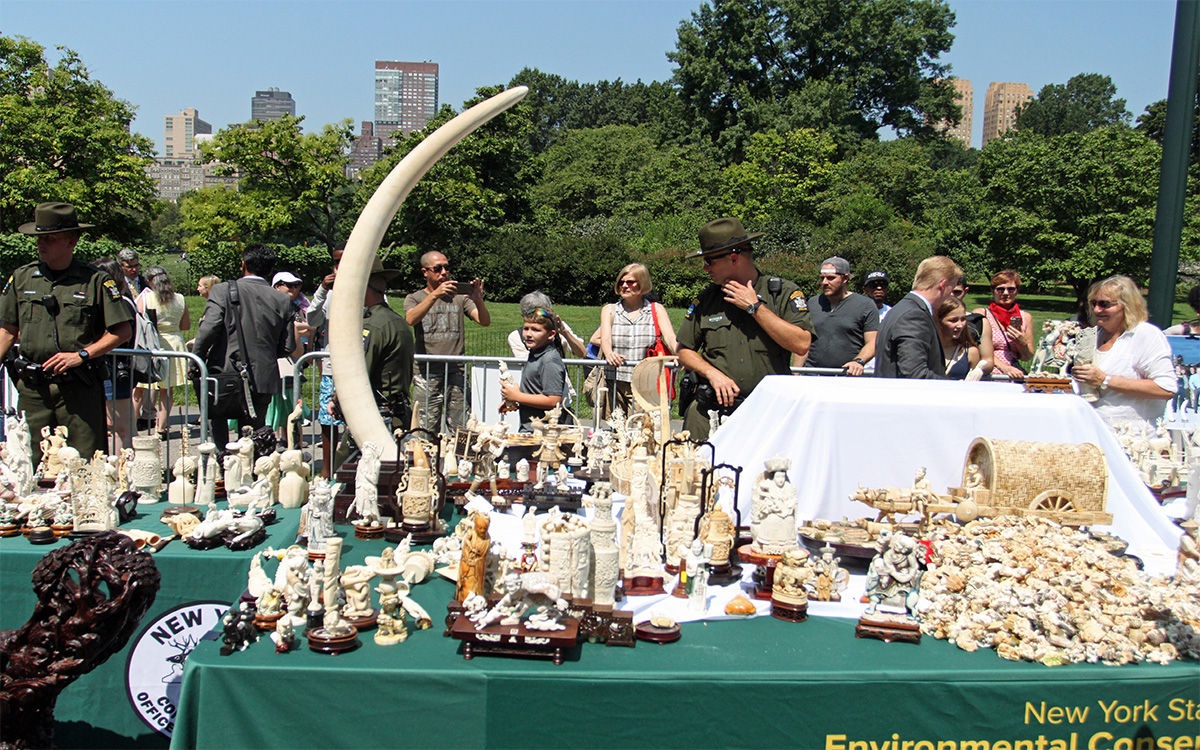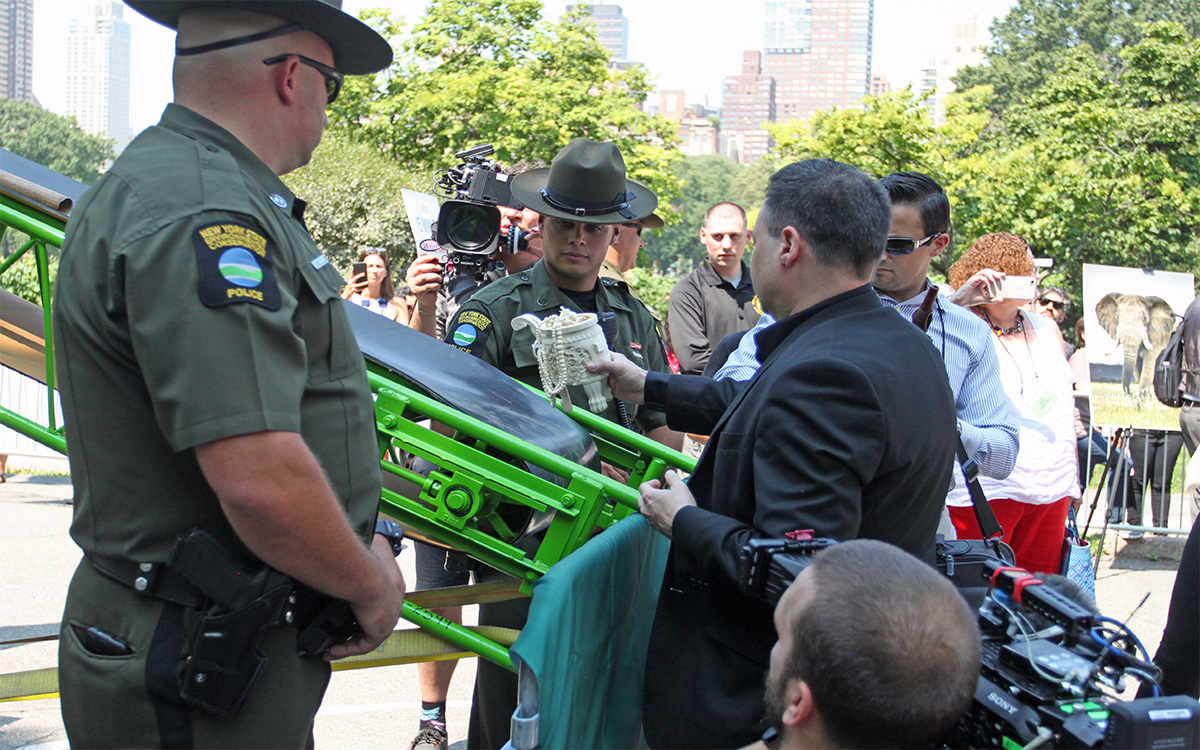New York Demonstrates Zero Tolerance for Illegal Wildlife Trade
$8.5 million of illegal ivory destroyed in Central Park

Photos by Rachel Nuwer
New Yorkers are accustomed to out-of-the-ordinary encounters on the city’s eclectic streets, but the scene Thursday morning in Central Park was enough to stop some in their tracks.
Under a cloudless blue sky, celebrities, politicians, and conservationists loaded 8.5 million dollars’ worth of illegal ivory onto the conveyor belt of a rumbling rock crusher. Into one end toppled kitschy figurines, cheap bangles, ornate carvings, and full tusks, and out the other shot a gritty white powder. By the time the machine powered down an hour later, the final remains of some 100 dead elephants had been pulverized into chips and dust.
Since the mid-2000s, African elephants have suffered from an escalating poaching crisis. Populations of savanna elephants dropped by 30 percent from 2007 to 2014, while numbers of forest elephants—West Africa’s more diminutive and secretive species—plummeted 62 percent from 2002 to 2011. Over 50 elephants are killed each day for their tusks, according to recent estimates.
“I don’t think the average person realizes that elephants are truly on the verge of disappearing,” said Major Scott Florence of the New York State Department of Environmental Conservation. “At the rate we’re going, African elephants could be extinct in the wild in 10 to 15 years.”
The declines have largely been driven by demand for ivory in Asia—especially China. But the United States also plays a significant role in the illegal ivory trade. As in most of the rest of the world, the ivory trade has been banned here since 1990. But unscrupulous dealers continue to smuggle in ivory from recently killed elephants, often labeling new carvings or jewelry as antique in an attempt to pass them off as legal.
Acknowledging their nations’ roles in the poaching crisis and illegal ivory trade, in 2015, former president Barack Obama and China’s president Xi Jinping agreed to work together to impose a near total ban on ivory in their respective countries. In mid-2016, Obama made good on that promise with regulations that severely restricted ivory trade across state lines. Shortly after, China announced that it planned to phase out its legal ivory market by the end of 2017.
Even before Obama stepped up federal rules, though, some states—including New Jersey, New York and California—were leading the charge against the illegal ivory trade within their jurisdictions. In 2014, New York governor Andrew Cuomo outlawed all ivory sales, save for a few exceptions (such as musical instruments made before 1975) and strengthened criminal and civil penalties for those caught selling or buying nonexempt pieces. Not everyone complied, however. Since the law went into effect, New York’s Department of Environmental Conservation has seized ivory worth more than $10 million from 16 corporations and 31 individuals.
“I view this day as a celebration of the rule of law,” said DEC Commissioner Basil Seggos, speaking at the crush. “New Jersey came first with its ivory ban, but when New York came, we came hard.”


The new laws and stepped-up enforcement seem to be working. In 2006 and 2007, investigators found nearly 17,000 ivory items for sale in the top three U.S. markets for ivory—New York, San Francisco, and Los Angeles—but a 2016 follow-up study published this July by the wildlife trade monitoring group TRAFFIC revealed a significant and encouraging decline. Investigators tallied only 489 ivory items in those three cities, and New York, formerly the country’s largest ivory market, dropped to third. (Some sellers, however, may have simply shifted their operations to places where it is easier to get away with trade. The investigators found an uptick in the amount of ivory for sale in Washington, D.C., for example, and discovered over 2,000 ivory items advertised on six major e-commerce sites.)
Thursday’s ivory crush marked the third such event in the United States, but Africa has pioneered the tradition. Public ivory destructions date back to 1989, when Kenya burned 12 tons of tusks and opened the world’s eyes to the elephant poaching crisis of the 1970s and 1980s. Since then, over 20 countries have crushed or burned more than 260 tons of ivory. No one knows exactly how much ivory is kept in government lockers and storehouses around the world, but the Convention on International Trade in Endangered Species estimates about 1,000 tons globally.
Some critics argue that destroying ivory may increase prices or desirability of ivory, because poachers, traffickers, sellers and buyers may perceive that less of the material is around. No empirical data, however, support such claims.
We do know, though, that burns and crushes alleviate the burden of keeping ivory. It’s costly to maintain secure lockers, and tons of ivory have disappeared from supposedly well-guarded stockpiles over the years. While theft is less of a concern in the United States, destroying the ivory is a logistical relief. “For New York to maintain an evidence room with almost $10 million worth of ivory and counting doesn’t make any sense,” Florence said. “We need to destroy it anyway, just so it doesn’t sit in our locker for years and years.”
Beyond solving a practical problem, though, ivory crushes and burns are symbolically valuable. New York’s crush reinforces the message to African nations that the U.S. stands with them in their fight against poaching—and encourages other countries to do the same. It also raises awareness about the poaching crisis and reminds the public of ivory’s illegality.
“This is about educating people: When buying ivory, they’re not just killing elephants but also supporting criminal activity in Africa and around the world,” said John Calvelli, executive vice president of public affairs at the Wildlife Conservation Society, one of the groups that organized the crush. “We’re sending the message that ivory should only be on elephants.”
 The Magazine of The Sierra Club
The Magazine of The Sierra Club






